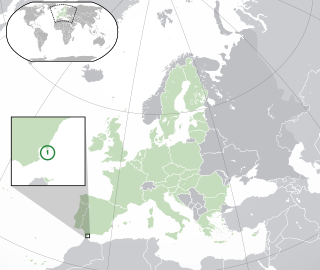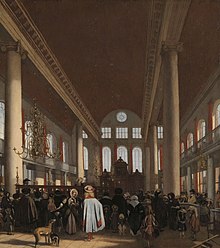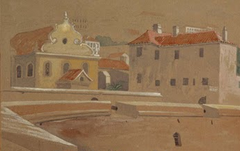Spanish and Portuguese Jews, also called Western Sephardim, Iberian Jews, or Peninsular Jews, are a distinctive sub-group of Sephardic Jews who are largely descended from Jews who lived as New Christians in the Iberian Peninsula during the few centuries following the forced expulsion of unconverted Jews from Spain in 1492 and from Portugal in 1497. They should therefore be distinguished both from the descendants of those expelled in 1492 and from the present-day Jewish communities of Spain and Portugal.
David Abudarham, referred to as Abudarham, Abudraham, or Avudraham, was a rishon who lived in Seville in the 14th century and was known for his commentary on the siddur.

The Portuguese Synagogue, also known as the Esnoga, or Snoge, is an Orthodox Jewish congregation and synagogue, located at Mr. Visserplein 3 in Central Amsterdam, Amsterdam, in the North Holland region of The Netherlands. The synagogue was completed in 1675. Esnoga is the word for synagogue in Judaeo-Spanish, the traditional Judaeo-Spanish language of Sephardi Jews.

The Great Synagogue of Gibraltar, also known as Kahal Kadosh Sha'ar HaShamayim, is an Orthodox Jewish congregation and synagogue, located in the British overseas territory of Gibraltar. It was the first synagogue on the Iberian Peninsula to operate following the Jewish expulsions from Spain and Portugal in 1492 and 1497 respectively. Completed in the 1720s, it is the oldest synagogue in continuous use in Gibraltar and is Gibraltar's principal synagogue.

The history of the Jews in Gibraltar dates from the fourteenth century. Despite periods of persecution, for the most part the Jews of Gibraltar have prospered and been one of the largest religious minorities in the city, where they have made contributions to the culture, defence, and the government.

Solomon Gaon (1912–1994) was a Sephardic Rabbi and Hakham of the Spanish and Portuguese Jews of the British Commonwealth.

Sephardic Bikur Holim Congregation (SBH) is an Orthodox Jewish congregation and synagogue in the Seward Park neighborhood of Seattle, Washington, in the United States, that practices in the Sephardic tradition.

The White Stork Synagogue is a Conservative Jewish congregation and synagogue, located in Wrocław, in the Lower Silesian Voivodeship of Poland. Designed by Carl Ferdinand Langhans in the Neoclassical style and completed in 1829, the synagogue is located in the city's center, which was the northern edge of the former Jewish district.
Jews' Gate Cemetery is a Jewish cemetery located on Windmill Hill within a nature reserve in the British Overseas Territory of Gibraltar. Also known as the Windmill Hill Cemetery, it is the site of the earliest known Jewish burials in Gibraltar. The cemetery opened by 1746 and closed in 1848. It is the burial site of a number of Gibraltar's Chief Rabbis. The graveyard is protected by the law of Gibraltar.

33 Rua do Carmo is an historical building located at 33 Rua do Carmo, Funchal, Madeira, Portugal. It is likely that the building was built in 1836 in the Moorish Revival style as the Sha'ar Hashamayim Synagogue or Funchal Synagogue, a former Jewish congregation and synagogue.

The Jewish Cemetery of Funchal is a Jewish cemetery located in Rua do Lazareto, Funchal, Madeira. Sephardi Jews as well as Ashkenazi Jews are buried here.

The history of the Jews in Madeira spans the entire length of the history of Madeira itself. The history of Madeira begins with the discovery of the islands by Portugal in 1419. Madeira is presently officially the Autonomous Region of Madeira, and is one of the two autonomous regions of Portugal. It is an archipelago situated in the north Atlantic Ocean, southwest of Portugal. According to the 2021 census, it had a total population of 250,744. The capital of Madeira is Funchal, which is located on the main island's south coast.
"Bar Yochai" is a kabbalistic piyyut extolling the spiritual attainments of Simeon bar Yochai, the purported author of the preeminent kabbalistic work, the Zohar. Composed in the 16th century by Rabbi Shimon Lavi, a Sephardi Hakham and kabbalist in Tripoli, Libya, it is the most prominent and popular kabbalistic hymn, being sung by Jewish communities around the world. The hymn is sung by Sephardi and Ashkenazi Jews alike on Lag BaOmer, the Yom Hillula of bar Yochai, and is also sung during synagogue services and at the Shabbat evening meal by certain groups. Incorporating expressions from the Tanakh, rabbinical commentaries, and the Zohar, the hymn displays its author's own mastery of Torah and kabbalah. According to Isaac Ratzabi, the song's use of "bar Yochai" is the probable reason for "bar Yochai"'s modern ubiquity.
The Hiloula of Rabbi Isaac Ben Walid is the yom hillula or death celebration of Isaac Ben Walid, who died in 1870. It is one of the most popular hilluloth in North Africa.
Abraham Levy was an English Orthodox rabbi, theologian, and author. He served as spiritual head of the Spanish and Portuguese Jewish community in Britain from 1962 to 2012, and was a founding member of Naima Jewish Preparatory School. Levy was appointed an Officer of the Order of the British Empire (OBE) for services on inter-faith co-operation in the 2004 New Year Honours.

The Abudarham Synagogue is an Orthodox Jewish congregation and synagogue, located at 19 Parliament Lane, in Gibraltar, a British overseas territory of the United Kingdom.

The Little Synagogue, officially Ets Hayim Synagogue, is an Orthodox Jewish congregation and synagogue, located at 91 Irish Town, Irish Town, in Gibraltar, a British overseas territory of the United Kingdom.

The Nefusot Yehuda Synagogue, officially the K K Nefusot Yehuda Synagogue, more commonly known as the Flemish Synagogue, sometimes known as the Lime Wall Synagogue, is an Orthodox Jewish congregation and synagogue, located at 65 Line Wall Road, in Gibraltar, a British overseas territory of the United Kingdom.













